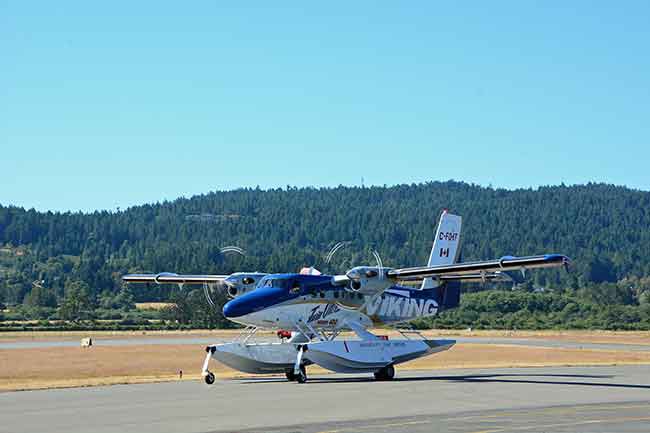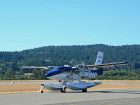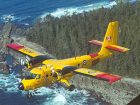
News
Rich in resources and opportunities
The times they are a changing on Vancouver Island. Long known as the land of big trees and even bigger salmon, Vancouver Island is home to an expanding high-tech and aerospace industry that has overtaken tourism on the economic scale.
March 5, 2016 By Paul Dixon
 Brand new Series 400 Twin Otter taxis at Victoria International Airport The times they are a changing on Vancouver Island.
Brand new Series 400 Twin Otter taxis at Victoria International Airport The times they are a changing on Vancouver Island.The Vancouver Island Aerospace Association (VIAA) was formed in 2015 to promote Vancouver Island aerospace to global markets. VIAA represents all sectors of aviation and aerospace on the Island – aerospace manufacturing and maintenance, airlines and air transport, ground-based infrastructure in the forms of airports and their networks as well as the region’s post-secondary institutions – that collectively fuel the engine that is building the future. That future is based on the same trade routes that led the first Europeans to these shores almost 250 years ago.
Europeans first arrived on the West Coast of what is now Canada in the late 1700s as part of what was then a global trade pattern. Sea otter pelts were highly-prized in China and were exchanged for tea, silk, porcelain and other goods that could be sold in Europe. The giant, first-growth forests provided masts and spars for the ships of the Royal Navy and by the 1850s, the British colony of Vancouver Island was established. The sea otter was hunted to the point of extinction, but by the time Vancouver Island joined with British Columbia and joined Confederation, forestry and mining along with fishing were the economic drivers. Victoria, now the capital of B.C., proudly saw itself as the last bastion of the British Empire. The island is long (480 kilometres) and narrow (80 kilometres at its widest), with rugged mountains running its length. More than half of today’s population of nearly 800,000 resides in metro Victoria on the very southern tip.
The growth industry today on Vancouver Island is in high tech, with a strong link to aerospace. Scott Dewis, vice-president of VIAA, grew up in Victoria and is a graduate of Camosun College and the University of Victoria. Initially he moved to Vancouver to work in high-tech, but moved back to Victoria and started his own business, Race Rocks 3D, because as he says, “there is a lot of entrepreneurial spirit here. People who have learned elsewhere and either came home to Vancouver Island or decided to settle here to start their own business. There is a high level of knowledge and coupled with that entrepreneurial spirit and international investment there is tremendous growth industry.” Today, Dewis develops technology enabled learning systems for a diverse list of clients in aerospace, defense and the oil and gas sector, including Boeing and the Royal Canadian Navy.
Viking Aviation, known across Canada and around the world, is the single largest player in the Vancouver Island Aerospace sector. Viking’s Series 400 Twin Otter has been a hit since the company re-introduced the iconic aircraft five years ago and recently announced sales into China and Russia, which illustrates just how strong the brand is.
Further up island in Campbell River, Sealand Aviation is known for its improvements to the DHC-2 Beaver, particularly its cabin extension kit and the Alaska door, as just two of many innovations. Campbell River is also home to ASAP Avionics, established in 1997 by Mark Sylvester. A couple of years earlier Sylvester, then living in Saudi Arabia, came to visit a friend in Campbell River. He quickly decided that this was the place he wanted to spend the rest of his life. It took time to work through the immigration process, but having noticed the number of floatplanes coming and going he saw an opportunity. Drawing on his experience in the Royal Air Force, ASAP Avionics was the result. He developed a wiring kit for the DHC-2 and a glass cockpit for the DHC-3 Otter as well as the Robinson R-44 and R-22 helicopters. Sylvester is currently president of the VIAA.
Staying connected
Transportation and connectivity have always been a challenge on the island, with a single highway running up the north-south axis on the east side and a single, winding highway running to west coast from mid-island to the communities Tofino and Ucluelet at either end of Long Beach. The First Nations who have lived up and down the coast for thousands of years were master mariners in their seagoing canoes. Today, there are still many isolated communities that can only be reached by boat or floatplane. Once floatplanes (and later helicopters) arrived on the West Coast, they became an integral part of the transportation system that is no less diminished today.
The body of water now known as the Salish Sea that lies between Vancouver Island and the mainland is not unlike the English Channel in many regards, creating a barrier that can be much more than just distance. BC Ferries carries approximately eight million passengers a year on its three major routes between the mainland and the island. While sailing time for the routes is between 90 minutes and two hours, the imposition on business travellers or those catching flights out of YVR is much greater, as many trips would require an overnight stay in Vancouver at both ends of a trip, given the logistics of ferry schedules.
Now, the airport community on Vancouver Island is meeting the needs of travellers and reaping the benefits. There are three major airports on Vancouver Island: Victoria (YYJ), Nanaimo (YCD) and Comox (YQQ), with community airports in Campbell River, Tofino and Port Alberni. Victoria has been the major airport on the island for years, with direct daily flights to major Canadian cities including Vancouver, Edmonton, Calgary and Toronto as well as direct flights to Seattle, San Francisco and Las Vegas, with seasonal flights to Hawaii and Mexico.
Halfway between Victoria and Comox, recent improvements at Nanaimo Airport give it the capability to accept up to B373 and A319 size aircraft. Currently, Air Canada offers service to Vancouver and Calgary, while WestJet offers direct flights to Calgary. Further up the Island Highway, Comox Valley Airport is proving to be a major economic force multiplier for the region known as North Island. The airport is actually a tenant of the Department of National Defence, with the terminal building and infrastructure located on the southern side of CFB Comox, home of 19 Wing and 407 Maritime Patrol Squadron and 442 Squadron Search and Rescue.
For years, the airport existed quietly out of portable buildings that were barely adequate for the small number of commuter flights that serviced the airport. That changed in 2001 when WestJet introduced service to Calgary. Since then, WestJet and WestJet Encore have added additional flights to Calgary and Edmonton as well as seasonal service to Puerto Vallarta, while Air Canada offers direct service to Vancouver. Regional carriers Central Mountain Air and Pacific Coastal Airline connect to Vancouver and smaller communities up and down the B.C. coast.
From a handful of passengers 15 years ago, Comox is on track to serve more than 330,000 passengers in 2016. Add that number to Nanaimo’s 280,000 and the 1.7 million for Victoria, don’t forget to include Helijet’s scheduled helicopter service to Victoria and Nanaimo from Vancouver. Then there’s Harbour Air, the world’s largest floatplane airline, and a handful of smaller operators connecting communities up and down the island to the mainland. Kenmore Aviation of Seattle operates daily scheduled floatplane service between Seattle and Victoria. All told, that’s close to three million passengers flying in and out of Vancouver Island and it’s important to realize that none of them are simply passing through. Every one of them is either starting or finishing their trip on the island.
Relationships that bind
Fred Bigelow, CEO of the Comox Valley Airport, explains the symbiotic relationship with the civilian airport and military sharing the same patch of land. As a retired RCAF brigadier-general and one-time 19 Wing CO, he has a unique perspective on the situation. He knows that operational requirements for the RCAF takes precedence at all times and at some point in the future if CF-18s were deployed to Comox, it could have a serious impact on passenger operations.
At the same time, the civilian airport has a 10,000 foot runway at its disposal, 24/7 ATC provided by the RCAF and dedicated fire/crash service. A significant benefit to 19 Wing is from having the staff at YQQ function as their air movement unit. “We have an office with a couple of techs and a counter in the terminal,” Bigelow explains. “When they are deploying people on a C-17, maybe going to Kuwait or wherever, this is where they load the freight, sort out the passengers and get the people on the plane.”
Perhaps the biggest benefit YQQ offers the military is the fact that it is a civilian airport with flights that can get parents and children on a flight to perhaps Disneyland or to visit family in Eastern Canada with minimal hassle, unlike the more isolated bases such as Cold Lake that are many hours removed from those flights. For families that are often separated for long periods by the demands of deployments, it’s a bonus. The quick connection through the airport is also a prime reason so many military personnel choose to retire in the region.
19 Wing is also home to the Canadian Forces School of Search and Rescue (CFSSR). Every year a class of candidates goes through an 11-month course at CFSSR to earn the right to wear the distinctive orange overall and earn the title SAR Tech. With the long overdue Fixed-Wing SAR (FWSAR) Replacement Project on the horizon, Bigelow realizes when the new aircraft is eventually selected there will be a requirement to train pilots and crew on the aircraft. Under the auspices of Comox Valley Economic Development, a committee comprised of retired senior military officers and representatives from the airport developed a report that presents Comox and 19 Wing as the logical choice for the location of a new FWSAR Training Centre. “This is the place to do it,” Bigelow says. “We’ve got the synergies with the existing school and the Cormorant school. It’s good for the military and it’s good for the community.”
What Comox lacks in terms of an FBO for business aviation and support for general aviation, can be found a short distance up the highway in Campbell River. Owned and operated by the City of Campbell River YBL is a full service, all weather airport with a 6,500 foot runway. The airports at Tofino and Port Alberni are both owned and operated by the Alberni-Clayquot Regional District.
Long Beach Airport will receive $1.27 million in funding from the new B.C. Air Access Program, part of “B.C. on the Move,” the Government of B.C.’s 10-year transportation plan. Improvements include improved runway lighting, with an eye towards serving the expanding tourist traffic into the region as storm watching, surfing and eco-tourism become increasingly popular.
The Alberni Valley Regional Airport (YPB) is a small, uncertified airport with a lack of infrastructure, but plans are underway to upgrade the airport, lengthen and widen the runway and install improved lighting. One of the immediate beneficiaries of the improved airport will be the Coulson Group, best known as the owners of the Martin Mars water bombers. Coulson has developed a modular tanking system that can be installed in C-130 Hercules aircraft, turning the aircraft into an aerial tanker. It has operated both in the U.S. and Australia.
When the AVRA improvements are finished, the aircraft will be homebased in Port Alberni. In November 2015 Coulson signed an MOU with Airbus Defense and Space that will see Coulson Group undertake the “industrialization, supply and support” of the new water bomber version of the Airbus C295W with a customized Coulson tank system. The airport expansion was a critical factor in Coulson being awarded the contract. Coulson started its tank program in 2012 and now employs about 60 people on the project and expects to hire more in the future. They will also be building a 60,000 square foot building at the AVRA.
Coulson Air Crane and VIH Helicopters of Victoria are global players in the rotary-wing world, with their heavy lift helicopters working around North America and around the world. Ascent Helicopters in Parksville and West Coast Helicopters of Port McNeil are two of the larger rotary companies on the island.
Educational opportunities
Post-secondary education is critical for future growth in the island’s aerospace sector. In 2014, the three universities and two colleges, with financial assistance from the provincial government, formed Vancouver Island Post-Secondary Alliance. The educational institutions work collectively with local businesses in order to understand how to best design their courses to meet future needs locally, nationally and globally. The University of Victoria is nationally and globally recognized as a top university, recognized as a leading research institution on a number of fronts including aerospace.
Royal Roads University in Victoria focuses on business and humanities, with most students already working professionals looking to broaden their education with a bachelor or master’s degree. Vancouver Island University (formerly Malaspina College) in Nanaimo operates as a regional university, incorporating trades and technical programs alongside academics. VIU has a research mandate that includes fisheries, aquaculture and economic development. An early boost to the partnership was an agreement between Boeing and the three universities that will see a student from each university taken into a paid internship by Boeing each year.
North Island College offers programs in Aircraft Structures Technician (AME-S) and Aircraft Sheet Metal Manufacturing Technician programs at its Campbell River campus. While Camosun College in Victoria doesn’t have a specific aerospace program, many of their students and graduates still end up working in aerospace. Camosun does have a strong interaction with local employers through its Technology Access Centre, which offers experts in technical design, 3D scanning and modelling, rapid prototyping, sensor integration and robotics. In July 2015, the provincial government provided Camosun with $1.5 million to create a testing interaction that will be part of the Trades Education and Innovation Complex currently under construction.
The University of Victoria Centre for Aerospace Research (CfAR) has been conducting research into unmanned vehicles and their applications since 2012 at their facility at Victoria Airport. Dr. Jenner Richards explains their work.
“We are involved in a lot of blue-sky stuff, but what makes us different is that we also design and fly machines for clients, who are actually collaborators in many cases,” Richards said. “We look at ourselves as a sandbox for industry. People have great ideas for UAVs, but they don’t have the resources or the know-how. They can come to UVIC and we can be their toolbox and test out their concept. We’ve done projects ranging from bird-scaring for a small company to move ducks off a field, to the other end of the scale where we work for companies like Boeing, Embraer and Bombardier where we look at advanced concepts such as aero-servo elasticity, flying aircraft that are fully instrumented and helping to build a database of information that they use to benchmark and create tools that are then used in the next generation of aircraft.”
One of their more interesting projects has been the Boeing SensorCraft project – a collaboration between the University of Victoria, Virginia Tech, the U.S. Air Force Research Lab and Boeing. The project involved the design, construction, ground and flight-testing of scale test aircraft for investigation into the next generation, high altitude, long endurance platform.
The aerospace community on Vancouver Island is a very inclusive community, integrated vertically and horizontally. Each strata is strongly interlinked with those above, below and beside it, but not totally interdependent. There is plenty of growth potential from top to bottom, a win/win situation that others would do well to take note of.

